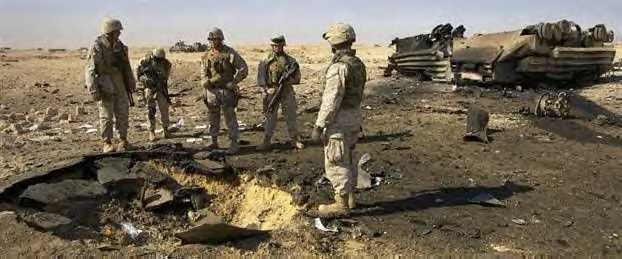Проблемы с такими машинами и тактикой их применения у амеров уже давно исторические. Предшественник LVTP-7 (LVPT-5) был совершенно не пригоден к маршу по трассе, и тем более к боевым действиям. Всё изделие было собрано как конструктор из частей от других систем. Двигатель и трансмиссия шли от танка М-48 и впритык влезали в габариты моторного отсека, что не только кошмарно усложняло регулярное обслуживание, но из за необходимости извлечение всего агрегата требовало по меньшей мере день работы для ремонта разных узлов, при этом в условиях мастерской автопарка.
Торсионно-эластичная (?) подвеска просто рассыпалась, т.к. совершенно не была предназначена для хода в режиме марша. Всё на что она была рассчитана так это выход на берег и всё. Конечно самой серьёзной проблемой являлась топливная система. Топливные баки буквально находились под днищем, топливо бензиновое, и даже от малой мины вся машина моментально возгоралось не давая экипажу возможности эвакуировать машину и спастись. Все модели страдают от неприемлемо плохой проходимости, и легко застревают как в песке так и в мягкой грязи.
Во Вьетнаме LVPT-5 называли "deathtrap", смертельная ловушка, точно также как называют LVTP-7/AAV7 в Ираке. Их применение в боевых действиях военнослужащие США считают "аморальным".
http://www.combatreform.org/amphibiousinfantrytanks.htmBloated AAV7 Deathtraps for our men in Iraq today
Fast forward to 2003...during Gulf War 2, "Operation Iraqi Freedom" (OIF) AAV7s were unwisely packed full of ammunition and rockets and driven through the city of Nasiriyah when a company of bloated amtracks got stuck in soft mud trying to bypass the town. Without tactical training and FLIR for drivers to use smokescreens, enemy RPG gunners poured rocket after rocket into AAV7s until they penetrated portions of the hull where there was no add-on armor and exploded the ammunition, rockets and fuel inside. We will refrain from revealing where the fuel is in AAV7s, but its location while better than the floor of the LVTP5s is still not wise. Dozens of marines were horribly killed and wounded.
The thing that is immoral is that 2 years later, the USMC is still driving around AAV7s packed full of ammo and men in Iraq with disastrous consequenses.
Сборник обзора инженерных просчетов, политической грызни и тактических ошибок которые до сих пор приводят к боевым потерям.
http://www.pmulcahy.com/tracked_apcs...acked_apcs.htm"FMC/GDLS LVTP-7/AAVP-7
Notes: Though development of what would become the AAVP-7 began in 1964, it was the first year of US involvement in Vietnam that really brought home to the Marines the shortcomings of the LVTP-5 series and the need for a better amphibious APC. The Marines quickly discovered that the LVTP-5 had a number of problems – it’s torsioelastic suspension, while it provided a comfortable ride over water and shore conditions such as rocks, sand, and reefs, was ill-suited for long trips and thus subject to frequent breakdowns. The LVTP-5 used the transmission and engine of the M-48 main battle tank – great for power, but not suited in the LVTP-5’s configuration; it could take a day of more to replace the power pack, and even routine service could require pulling out large amounts of the power pack just to get to the components to be serviced. Perhaps the greatest problem with the LVTP-5 as used in Vietnam lay with the fuel system; the tanks were under the floor, the engine ran on gasoline, and as the entire vehicle was lightly armored in the first place, even an antipersonnel mine explosion could sometimes turn the interior into a fiery slice of hell.
Because many of the LVTP’s problems were caused by improper employment of the vehicle, the Marines wanted something new that could take on roles Amtracs of the past could not. One of the first things to go was the torsioelastic suspension, replaced with a conventional torsion bar suspension on what was then called the LVTP-7 (later changed to AAVP-7). The armor protection was considerably upgrade, using the same 5083 aluminum armor that was used on the M-113 series. The engine chosen was a supercharged 400-horsepower 8V53T diesel truck engine with an HS-400 transmission; more importantly, the powerpack was a unified unit that could easily be lifted out of the vehicle in a matter of minutes with the proper equipment. The transmission was semiautomatic – it required no clutch, but still required gear selection on the part of the driver. The tracks were almost 54 centimeters wide for traction on soft sand as well as marshy conditions, and water propulsion was provided by two waterjets at the rear. Many other ideas were added, thrown out, or modified, and that, combined with political wrangling, meant that first deliveries of the LVTP-7 did not occur until 1972."
Отзывы служак Иракской оккупации, начиная с 2003 года;
http://blog.usni.org/2011/02/22/repl...ghting-vehicleSeeing how the LVTP-7 (my time period of service) was such a horrible ride, and so poorly protected (aluminum), and seeing the M-1 tanks vulnerabilities in close battle in Iraq, it seems clear that the AAV needs to be replaced and NOTHING is going to protect Marines from AGMs and IEDs to any great extent in the future.








 Ответить с цитированием
Ответить с цитированием